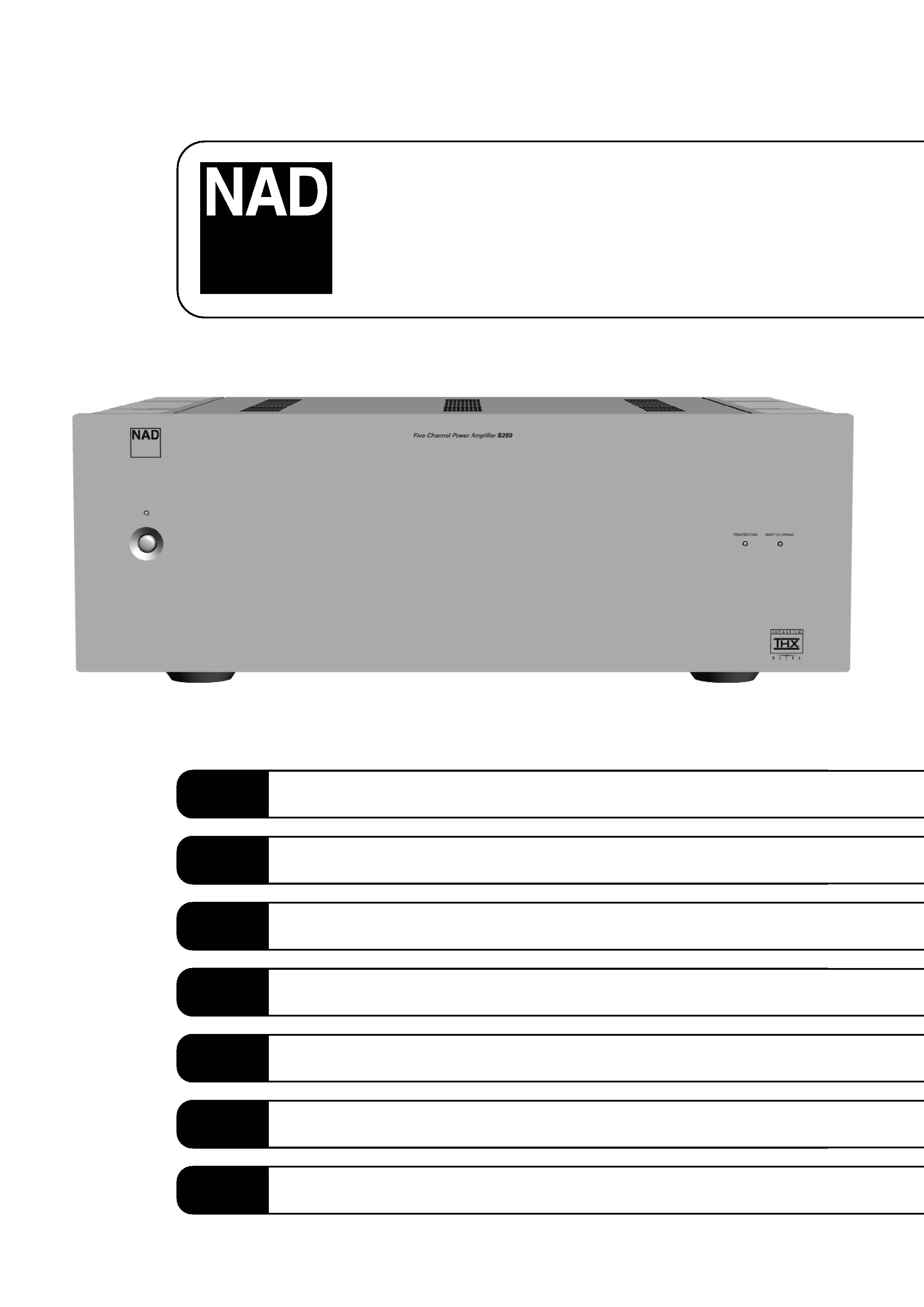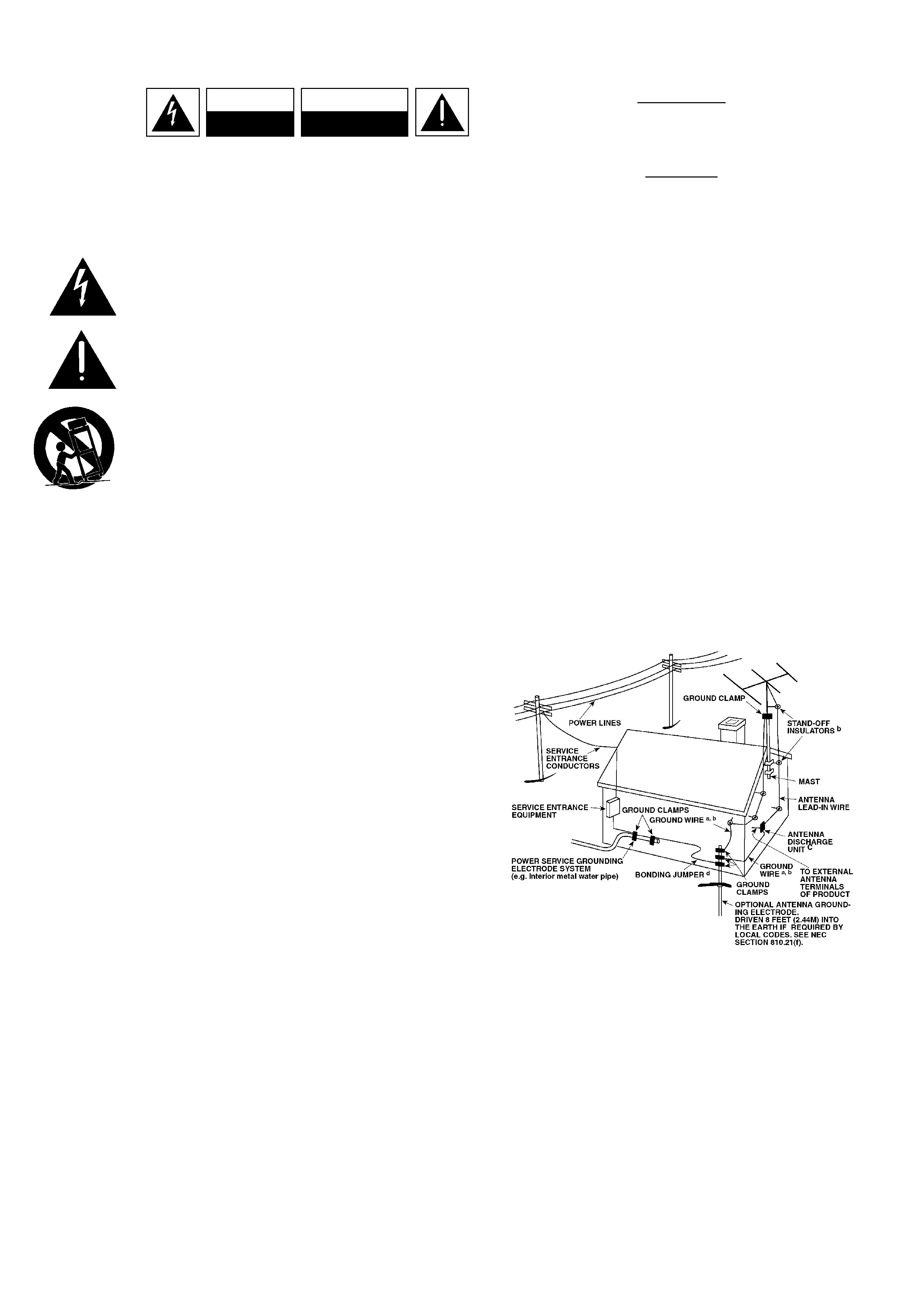
S250
Five Channel Power Amplifier
Owner's Manual
GB
Manuel d'Installation
F
Bedienungsanleitung
D
Manual del Usuario
E
Manuale delle Istruzioni
I
Manual do Proprietário
P
Bruksanvisning
S

Warning: To reduce the risk of fire or electric shock, do not
expose this unit to rain or moisture.
The lightning flash with an arrowhead symbol within an equilateral
triangle, is intended to alert the user to the presence of uninsulated
"dangerous voltage" within the product's enclosure that may be of
sufficient magnitude to constitute a risk of electric shock to persons.
The exclamation point within an equilateral triangle is intended to
alert the user to the presence of important operating and
maintenance (servicing) instructions in the literature accompanying
the product.
Do not place this unit on an unstable cart, stand or tripod, bracket
or table. The unit may fall, causing serious injury to a child or adult
and serious damage to the unit. Use only with a cart, stand, tripod,
bracket or table recommended by the manufacturer or sold with
the unit. Any mounting of the device on a wall or ceiling should
follow the manufacturer's instructions and should use a mounting
accessory recommended by the manufacturer.
An appliance and cart combination should be moved with care.
Quick stops, excessive force and uneven surfaces may cause the
appliance and cart combination to overturn.
Read and follow all the safety and operating instructions before
connecting or using this unit. Retain this notice and the owner's
manual for future reference.
All warnings on the unit and in its operating instructions should be
adhered to.
Do not use this unit near water; for example, near a bath tub,
washbowl, kitchen sink, laundry tub, in a wet basement or near a
swimming pool.
The unit should be installed so that its location or position does not
interfere with its proper ventilation. For example, it should not be
situated on a bed, sofa, rug or similar surface that may block the
ventilation openings; or placed in a built-in installation, such as a
bookcase or cabinet, that may impede the flow of air through its
ventilation openings.
The unit should be situated from heat sources such as radiators,
heat registers, stoves or other devices (including amplifiers) that
produce heat.
The unit should be connected to a power supply outlet only of the
voltage and frequency marked on its rear panel.
The power supply cord should be routed so that it is not likely to be
walked on or pinched, especially near the plug, convenience
receptacles, or where the cord exits from the unit.
Unplug the unit from the wall outlet before cleaning. Never use
benzine, thinner or other solvents for cleaning. Use only a soft
damp cloth.
The power supply cord of the unit should be unplugged from the
wall outlet when it is to be unused for a long period of time.
Care should be taken so that objects do not fall, and liquids are not
spilled into the enclosure through any openings.
This unit should be serviced by qualified service personnel when:
A. The power cord or the plug has been damaged; or
B. Objects have fallen, or liquid has been spilled into the unit; or
C. The unit has been exposed to rain or liquids of any kind; or
D. The unit does not appear to operate normally or exhibits a
marked change in performance; or
E. The device has been dropped or the enclosure damaged.
DO NOT ATTEMPT SERVICING OF THIS UNIT
YOURSELF. REFER SERVICING TO QUALIFIED
SERVICE PERSONNEL
Upon completion of any servicing or repairs, request the service
shop's assurance that only Factory Authorized Replacement Parts
with the same characteristics as the original parts have been used,
and that the routine safety checks have been performed to
guarantee that the equipment is in safe operating condition.
REPLACEMENT WITH UNAUTHORIZED PARTS MAY RESULT IN FIRE,
ELECTRIC SHOCK OR OTHER HAZARDS.
ATTENTION
POUR ÉVITER LES CHOC ELECTRIQUES, INTRODUIRE LA
LAME LA PLUS LARGE DE LA FICHE DANS LA BORNE
CORRESPONDANTE DE LA PRISE ET POUSSER JUSQU'AU
FOND.
CAUTION
TO PREVENT ELECTRIC SHOCK, MATCH WIDE BLADE OF
PLUG TO WIDE SLOT FULLY INSERT.
If an indoor antenna is used (either built into the set or installed
separately), never allow any part of the antenna to touch the metal
parts of other electrical appliances such as a lamp, TV set etc.
CAUTION
POWER LINES
Any outdoor antenna must be located away from all power lines.
OUTDOOR ANTENNA GROUNDING
If an outside antenna is connected to your tuner or tuner-
preamplifier, be sure the antenna system is grounded so as to
provide some protection against voltage surges and built-up static
charges. Article 810 of the National Electrical Code, ANSI/NFPA No.
70-1984, provides information with respect to proper grounding of
the mast and supporting structure, grounding of the lead-in wire to
an antenna discharge unit, size of grounding conductors, location of
antenna discharge unit, connection to grounding electrodes and
requirements for the grounding electrode.
a. Use No. 10 AWG (5.3mm2) copper, No. 8 AWG (8.4mm2)
aluminium, No. 17 AWG (1.0mm2) copper-clad steel or bronze
wire, or larger, as a ground wire.
b. Secure antenna lead-in and ground wires to house with stand-off
insulators spaced from 4-6 feet (1.22 - 1.83 m) apart.
c. Mount antenna discharge unit as close as possible to where lead-
in enters house.
d. Use jumper wire not smaller than No.6 AWG (13.3mm2) copper,
or the equivalent, when a separate antenna-grounding electrode
is used. see NEC Section 810-21 (j).
EXAMPLE OF ANTENNA GROUNDING AS PER NATIONAL ELECTRICAL
CODE INSTRUCTIONS CONTAINED IN ARTICLE 810 - RADIO AND
TELEVISION EQUIPMENT.
NOTE TO CATV SYSTEM INSTALLER: This reminder is
provided to call the CATV system installer's attention to
Article 820-40 of the National Electrical Code that provides
guidelines for proper grounding and, in particular, specifies
that the ground cable ground shall be connected to the
grounding system of the building, as close to the point of
cable entry as practical.
CAUTION
RISK OF ELECTRIC
SHOCK DO NOT OPEN
ATTENTION:
RISQUE DE CHOC ELECTRIQUE
NE PAS OUVRIR
CAUTION: TO REDUCE THE RISK OF ELECTRIC
SHOCK, DO NOT REMOVE COVER (OR BACK). NO
USER SERVICEABLE PARTS INSIDE. REFER SERVICING
TO QUALIFIED SERVICE PERSONNEL.
IMPORTANT SAFETY INSTRUCTIONS
2

3
FRONT PANEL CONTROLS
REAR PANEL CONNECTIONS
FIGURE 1
©2000
NAD
S250
©2000
NAD
S250

GB
4
NAD S250 Five Channel Power Amplifier
ABOUT THE S250
Designed specifically for home theater and custom installation set-
ups, the NAD S250 Power Amplifier delivers uncompromising
performance. It combines supreme reliability, flexibility, and
performance with outstanding value. Flexibility has always been an
important part of NAD components. Such flexibility is particularly
important in home theater and other multi-channel systems. That's
because it is common for a multi-channel system to incorporate
different brands and models of loudspeakers. Often these speakers
have different levels of efficiency. The individual input level controls
for the five channels of the NAD S250 make it easy to compensate
for such differences in efficiency, and achieve the ideal system
balance. Ample dynamic headroom of the S250 ensures that the very
wide dynamic range of modern cinema soundtracks and digital
music sources will be preserved. In addition, the S250 will handle low
impedance speakers with ease.
The S250 incorporates NAD's unique Soft-Clipping circuitry in all five
channels. Any amplifier can be overdriven if it is played too loud,
exceeding the maximum output power. Under such circumstances,
amplifiers produce extreme high levels of distortion which, besides
sounding very unpleasant, can damage your loudspeakers. The Soft
Clipping circuit suppresses such distortion and minimizes the risk of
damage to speakers. This is particularly important with movie
soundtracks which often contain very dynamic outbursts in which,
unlike music, it is difficult to hear this potentially damaging
distortion. The Soft Clipping LED on the front panel illuminates when
the Soft Clipping circuit is engaged. Soft Clipping can be defeated
with a rear panel switch.
The 12V trigger connection on the back panel allows the amplifier to
be switched from On to Stand-by and vice-versa remotely. This way,
the S250 can be part of a system which can be turned on and off
with a single command, easing operation. The 12V trigger also
allows the amplifier to be installed in places not in easy reach.
THE DESIGN
The NAD S250 houses five individual amplifiers, each on separate
circuit board. Each amplifier channel acts as a "mono block" within
the chassis. Each input connector, and set of loudspeaker output
terminals, is directly connected to that channel's circuit board. This
design eliminates extra wiring and keeps signal paths short.
Furthermore, this modular design increases reliability and thermal
efficiency. The input circuit uses a totally new dual differential input
topology that operates in true Class-A mode. The special
HolmgrenTM toroidal transformer has less hum and magnetic leakage
than conventional toroidal transformers, but retains the usual
benefits of high efficiency and high power-to-weight ratio.
Ruggedness and reliability are critical in custom-installed systems. The
S250 uses a combination of fuses and non-intrusive electronic
protection. This provides highly effective protection that does not
effect audio performance. Each channel is protected against excess
temperature, DC fault and loudspeaker short-circuit. The S250's
inherently conservative, high-voltage/high-current output stage has
been designed for years of trouble-free service.
NAD was the first company to introduce a THX certified power
amplifier. In that tradition, the S250 easily passes Lucas Films'
stringent THX performance requirements. As a result the NAD S250
will handle the most demanding signals with ease, and yet preserve
every subtle audio detail in the most demanding THX and Dolby
Surround systems.
INSTALLATION PRECAUTIONS
WARNING - To reduce the risk of fire or electrical shock, do not
expose the amplifier to rain or moisture.
CAUTION - For units factory-set at 115 volts AC match the wide
blade of the power plug to the wide slot of the power outlet, to
prevent electrical shock. Be sure the plug is completely inserted into
the receptacle.
Turn off all the components in the system whenever connecting or
disconnecting any audio signal wiring. Once all signal connections
have been completed, turn down all the system's main volume control
before turning the system components on. Then increase the volume
control setting carefully to avoid damage to the system components.
NOTES ON INSTALLATION LOCATION
Read and follow all the safety instructions on the first page of this
manual. To prevent a fire or shock hazard, do not place the amplifier
where it will be exposed to any water or moisture. If liquid
accidentally gets into the amplifier, immediately unplug the AC
power cord. Do not operate the amplifier again until it has been
examined by a service technician.
The amplifier generates a moderate amount of heat, requiring
ventilation. Do not obstruct the air outlet grilles on the top or
bottom covers. There should be at least 3 inches (7.5 cm) of
clearance above the amplifier and 1 inch (2.5 cm) to the sides. Do
not place the amplifier in an enclosed area, such as in a bookcase or
in a cabinet, unless it is very well ventilated. Be sure there is
adequate room behind the amplifier for signal input and speaker
output connections. If you want to locate the amplifier on a carpeted
floor, place a board under it in order to prevent it from sinking into
the carpet, blocking the air inlets on the bottom. Do not place the
amplifier where it will be exposed to direct sun light for prolonged
periods of time.
This unit may be installed on any sturdy, level surface.
NOTE: The amplifier's weight must always rest on its bottom feet.
Never put the amp down on its rear panel, with its front panel facing
up. Doing so risks damage to the input/output connectors.
The power transformer in the S250 generates a magnetic hum field
of moderate strength. Turntables (especially those with a moving-coil
pickup cartridge) should not be located near the amplifier. Magnetic
media, such as audio or video tapes and computer diskettes, should
not be stored near the amplifier.

REAR PANEL CONNECTIONS/CONTROLS
1. AC LINE CORD
Plug the AC line cord into a nearby wall outlet that provides the
correct AC power line voltage, as indicated on the back panel of the
unit. Do not plug the amplifier into a convenience outlet on your
preamp. The amplifier requires more power than these outlets
typically can provide.
2. INPUTS
Each of the five independent power amplifiers within the S250 has
its own signal input connector. Before making any connections to the
amplifier, make sure the POWER is switched OFF.
Connect the signal cables from the preamplifier, surround sound
decoder, or other signal source to these inputs. For optimum heat
dissipation in an AV surround system, we recommend you allocate
the audio channels to the inputs as follows:
Input 1 = Right Main speaker
Input 2 = Right surround speaker
Input 3 = Center speaker
Input 4 = Left Surround speaker
Input 5 = Left Main speaker
3. INPUT LEVEL CONTROLS
The amplifier is equipped with separate input level controls for each
channel. Before turning on the S250 for the first time, make sure all
level controls are in their normal full-clockwise position. With the
input levels set to the maximum position, the gain is exactly
conforming to THX UltraTM standards.
Under some circumstances, other settings may be useful for:
· Level-matching - In systems that incorporate speakers of varying
efficiencies, it may be necessary to reduce the settings of some
controls to achieve proper channel-to-channel balance.
· Extended volume-control range - Many stereo systems have so
much voltage gain that the speakers (or your ears) are over-driven
at any volume-control setting higher than 11 or 12 o'clock
position of the volume control. As a result you can use only the
lower half of the volume control's range, where adjustments are
imprecise and channel-balance errors tend to be greater. If all
input level controls are reduced, you can turn up your
preamplifier's volume control, making effective use of most of its
range. (Suggestion: Adjust the input level controls so that your
preferred maximum sound levels occur at about 2 or 3 o'clock on
the volume control.) As an added benefit, this procedure
suppresses any noise produced by the preamp's high-level circuitry
(e.g. any residual hum or hiss that does not go away when the
Volume is turned down).
4. SPEAKER CONNECTIONS
This amplifier is equipped with special high-current binding-post
speaker terminals. Connect the loudspeakers with heavy-duty (16-
gauge or thicker) braided wire. Connections may be made in any of
three ways. [See Figure 1.]
· Strip off a half-inch (1 cm) of insulation from each speaker wire.
In each conductor, twist the thin strands of wire together.
Unscrew the knob, insert the bare wire into the opening at the
base of the binding post, and tighten the knob until it grasps the
wire securely. Check to be sure that there are no loose strands of
wire touching the chassis or an adjacent terminal.
· Spade lugs. Unscrew the knob, insert the U-shaped spade lug
behind the bushing, and tighten the knob until the spade lug is
secured.
· Install banana plugs on your speaker wires, and plug them into
the end of each binding post. The terminals are separated by 3/4
inch (l9mm), so they will accept dual-banana plugs (this option is
not available on units with 230V line voltage factory setting).
NOTE: Speakers must operate in phase with each other in order to
produce a proper stereo image and to reinforce rather than cancel
each other's output at low frequencies. When connecting speakers,
take care that the red (positive) terminal on each loudspeaker is
connected to the corresponding terminal marked red (positive) on
the amplifier.
5. AUTO TRIGGER ON/OFF
With the Auto Trigger switch set to the On position to activate the
12V-trigger. By connecting the 12V-trigger, the S250 can be remotely
switched to On and Stand-by and vice-versa. When set to the Off
position, the 12V-trigger input is not active.
NOTE: With the Auto Trigger switch set to the ON position and the
12V-trigger input connected, the S250 will switch from Off to Stand-
by when the Power Switch on the front panel is pressed. For normal
operation, ensure the switch is in the OFF position or that the 12V-
trigger input socket is not connected.
6. 12V-TRIGGER INPUT
For external Power on/Stand-by switching, connect the 12V-trigger
output of a source component to this DC input jack. The center pin
is the live or + connection, the outer sleeve of the input jack is the
12V-trigger - or ground connection.
NOTES: The S250's 12V-trigger will work within a range of 6 to 15 V
DC level and typically draws less than 10mA of current. Check the
specifications of the 12V-trigger source to ensure it is compatible
with the S250's 12V-trigger input. Do not exceed the recommended
voltage as this may cause damage to the S250.
If no cable is attached to the 12-trigger input socket on the S250's
back-panel, the Power Switch will operate as normal, even if the
Auto Trigger switch on the back panel is in the ON position.
GB
5
